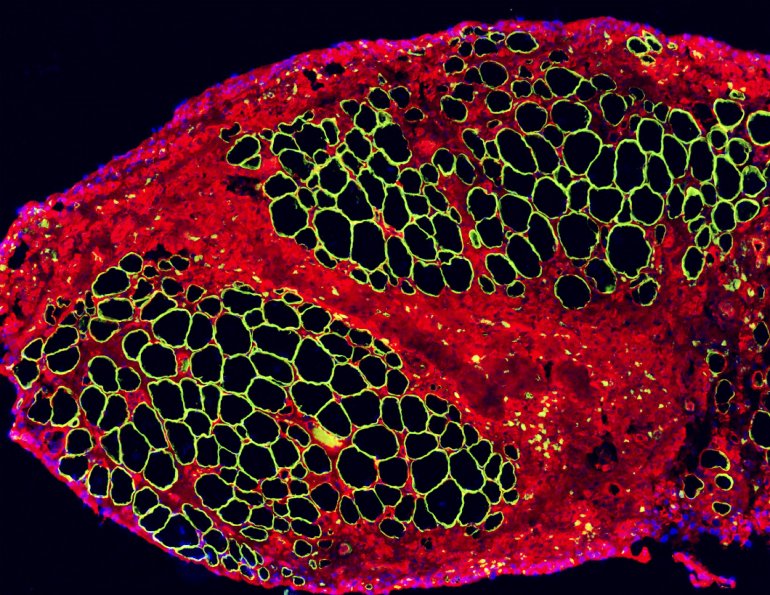Regenerating Muscle from Stem Cells
UCSF News reports on research by Xiaoti Xu, M.D. and a team in the Pomerantz Lab showing that human muscle stem cells could be transplanted into a new environment and have the capacity to regenerate lost muscle tissue. Dr. Xu is a UCSF Plastic Surgery Resident and former research fellow in the lab.
The image shows cross-sectioned muscle fibers as black shapes outlined in green. The catch: these are human muscle fibers, grown from human stem cells.
Xiaoti Xu, MD, a resident physician in UC San Francisco’s Division of Plastic and Reconstructive Surgery, studies a type of stem cell called satellite cells, or muscle stem cells. Xu became interested in muscle stem cells because of his experiences as a clinician.
“Our inability to generate healthy, living muscle is a huge shortcoming,” Xu said. To reconstruct a cancer patient’s shoulder after surgical removal of a tumor, for example, Xu and his colleagues transfer a large amount of muscle from the patient’s abdomen or leg. These living muscle transfers take eight to 12 hours, followed by a long and painful recovery process for the patient.
“Imagine losing a whole piece of muscle the length of your thigh – how much pain you would have to go through,” Xu said.

Cross-sectioned muscle fibers are shown as black shapes outlined in green. Image by Xiaoti Xu and Hua Tian
Xu wondered if instead, healthy muscle could be grown ahead of time from muscle stem cells. Thanks to the support of his residency program, Xu worked with Jason Pomerantz, MD, to take a problem from the operating room into the lab. Xu successfully isolated human muscle stem cells and tested their ability to grow new muscle by transplanting them into injured mice.
About the Pomerantz Lab
 Led by Jason H. Pomerantz, M.D., Associate Professor of Surgery and Surgical Director of the UCSF Craniofacial Center, the Pomerantz Lab studies basic and translational aspects of tissue regeneration. With foundations in muscle and cancer biology, the lab investigates regenerative mechanisms including stem cell development and de-differentiation. Using model organisms such as zebrafish and mice, and extending discoveries to human cells and tissues, the lab hopes to gain fundamental insight that can be translated into clinical advances, notably solving the structural and reconstructive problems of the limbs, face, and head, whether congenital or acquired.
Led by Jason H. Pomerantz, M.D., Associate Professor of Surgery and Surgical Director of the UCSF Craniofacial Center, the Pomerantz Lab studies basic and translational aspects of tissue regeneration. With foundations in muscle and cancer biology, the lab investigates regenerative mechanisms including stem cell development and de-differentiation. Using model organisms such as zebrafish and mice, and extending discoveries to human cells and tissues, the lab hopes to gain fundamental insight that can be translated into clinical advances, notably solving the structural and reconstructive problems of the limbs, face, and head, whether congenital or acquired.
